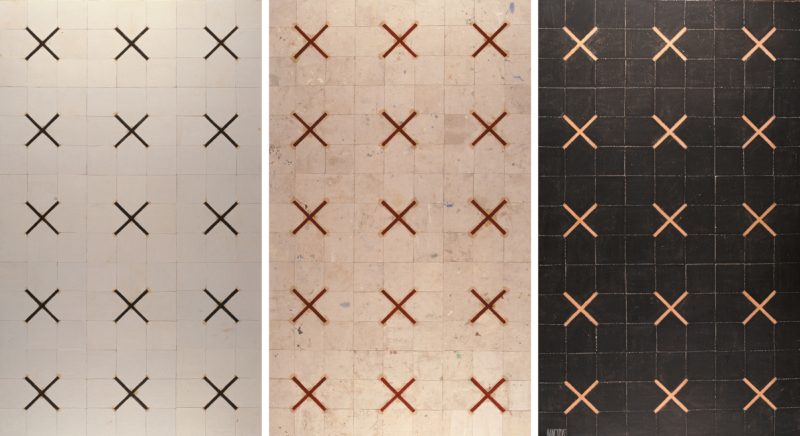HIGHT, Michael;
Rangiriri (triptych)
1996
Blackboard paint, oil, resin, found canvas and cloth on board
3 pieces; 1500 x 900mm (each piece); 1500 x 2700mm (overall)

The following two texts were written for Te Huringa/Turning Points and reflect the curatorial approach taken for that exhibition.
Peter Shaw
This work was first exhibited at Gow Langsford Gallery, Tāmaki Makaurau, in a show titled Four Strong Winds, the physical, intellectual, and emotional starting point of which was the Waikato River. The artist had travelled along the banks of the Waikato, Waipā, and Mokau rivers looking at the flow of water, landscape forms, buildings and their materials, and engaging with the various historical associations of particular sites. The black, red, and white panels, and the tied crosses invoke both Māori and Pākehā art forms.
On 20 November 1863, Rangiriri was the site of one of the fiercest military engagements during the invasion of the Waikato by British imperial forces led by General Cameron. Lasting two days, and involving great loss of life on both sides, the fighting came to an end when Māori surrendered for lack of ammunition. Among parties of reinforcements who had to turn back on receiving news of the surrender was one led by Te Heuheu Horonuku. General Cameron resigned in 1865, repudiating his part in the Waikato war in the belief that it was solely driven by settler greed for land.
This painting is intended to invoke the cultural tensions of that time. The artist’s carefully chosen materials are highly relevant to fire, water, bloodstains, discarded things.
Jo Diamond
This highly abstract, three-panelled form invokes tukutuku. However, unlike the panels of wharenui, usually made by two women, working in harmonious rhythm to thread fibres through the wooden slats, this ‘tukutuku’ does not imply partnership. It tells a story of racial conflict, deeply imprinted on to a landscape. The weaving of cloth, canvas, paint, resin, and oil diverges from the standard tukutuku materials. It echoes Land Wars in which two sides both suffered a bloody outcome.
The work also offers a strange tangibility and familiarity, never distancing itself far from the idea of walls and panels found within Māori or Pākehā houses. The artificial ‘walls’ implied by Rangiriri are noticeably temporary in nature, like those of a tent, never fully stable yet providing make-shift shelter. Here, shelter also comes from the landscape, despite its war-torn past. Within that landscape, we try to build homes using new technologies in the hope of warding off new invasions, stabilising our existence against violation and disease. Like the more conventional tukutuku panel, Rangiriri provides a focal point for meditation. It encourages us to remember a torn and burnt past and to search for a better future.
Inscriptions
CHURCHILL ROAD [l.r., panel 2] RANGIRIRI [l.l., panel 3]Exhibition History
Te Huringa/Turning Points: Pākehā Colonisation and Māori Empowerment, Sarjeant Gallery Te Whare o Rehua, Whanganui, 8 April to 16 July 2006 (toured)
Four Strong Winds, Gow Langsford Gallery, Tāmaki Makaurau, 1996
Provenance
1996–
Fletcher Trust Collection, purchased from Gow Langsford Gallery, Tāmaki Makaurau, November 1996

